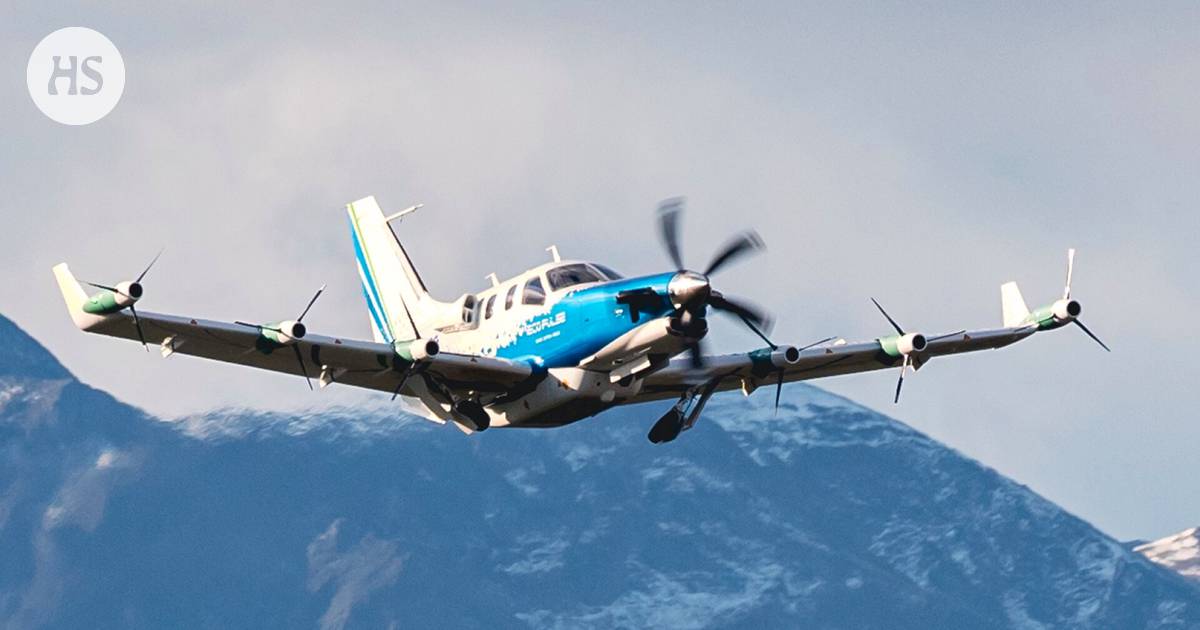imagine, that a slightly unusual-looking and perhaps strangely quiet airplane lands in the parking lot of a supermarket or factory. A group of passengers board the plane, which takes off from an area smaller than a football field.
It sounds like the dream of researchers and inventors, but agile electric or partially electric airplanes are already being developed by commercial operators.
The focus is now on hybrid technology, with which several companies plan to start electrified flying around 2028.
A hybrid airplane uses liquid fuel alongside the electricity charged to the batteries. The machine has several engines. For example, the European Airbus EcoPulse aircraft has one internal combustion engine and six electric motors.
Usually, the fuel is low-emission, renewable aviation fuel, which the aviation industry calls SAF, i.e. “sustainable aviation fuel”
Finn Lie already organizes traditional flights mainly for companies. Now the company is interested in hybrid machines.
“Lygg creates direct connections between companies that need air connections and service providers,” say the company’s founders Roope Kekäläinen and Jari-Jussi Viinikkala .
“When there are enough passengers, we organize a flight. We bring the fleet closer to actual passengers and their needs.”
The company had a turnover of a couple of million last year. Traffic flows are still thin and flights are mostly regional.
In December, the company and operating in Virginia, USA Electra fit cooperation For providing Electra ESTOL hybrid aircraft as a service to airlines. Electran kone flies 900 kilometers and takes nine passengers.
“Hybrid aircraft with 8-14 passenger seats will be available in a few years, this decade. Fully electric machines will come in the next decade”, Kekäläinen and Viinikkala describe.
“With a hybrid, carbon dioxide emissions can be quickly reduced by 95 percent compared to traditional aviation. It’s already a lot, although less than one hundred percent sometime in the future.”
Electra’s small plane has been developed for short runways.
A lot research has been needed before Electra’s small test plane flew last year.
Aerodynamics and aeronautical engineering researchers at the Massachusetts Institute of Technology (MIT). John Hansman and Mark Drela are technical advisors.
They developed the “short runway” airplane concept while working at MIT’s Department of Aeronautics and Astronautics. Particular Aeroastro studies air flows on aircraft surfaces, nowadays with the help of high-powered computers.
So are the US Air Force and Space Administration Nasa have supported high-precision aerodynamics simulations.
The result is a technology whose original name “blowing lift” can be translated as “blowing lift”.
The idea is to blow air over the wing and landing gear in such a way that more lift is obtained. The vane turns the air flow downwards. Thanks to the increased lifting force, you can take off and land at low speeds.
The idea was tried for the first time already in the 1960s, but the machine turned out to be too complicated. Now the increase in computing power in planning and the use of electrical devices in structures have made the technology practical, says Aviation Week.
Electra can take off from a distance of about one hundred meters, while a regular small plane requires almost a kilometer of runway. An area 100 times 30 meters is sufficient for the field. According to Lygg, there are hundreds of thousands of squares in Europe that are suitable for airports.
A speed of just under 50 kilometers per hour is enough to leave the runway. Today, a pilot can only take off with a small plane at a speed of a little over one hundred kilometers per hour. With large machines, leaving the ground requires a speed of 250–300 kilometers per hour.
Compared to machines that ascend vertically, the ascent requires much less energy, according to Electra, only one tenth.
Electrified regional flying will also be launched in Electra’s home country of the United States. Company JSX offers hop-on-board flight services, in the area between private and charter flights.
The company plans to introduce the first hybrid aircraft in 2028. Some will come from Electra, some from Swedish Heart Aerospace.
The third supplier is the French company Aura Aero, which promises that its machines will arrive a little later, by 2030, the news agency says Reuters.
in France Airbusin hybrid airplane EcoPulse took off at the end of November. The test flight lasted about one hundred minutes.
Builders added to the commercial Hence TBM 900 -batteries for the airplane and six electric motor-powered propellers for the wings. The plane can fly 1,800 kilometers and carry five passengers.
EcoPulse is intended as a model piece. A commercial machine will be something else, but the sample device has shown that the technology is feasible.
The Swedish Heart Aerospace has developed both electric airplanes and hybrids.
Also hybrid machines are being developed for slightly larger numbers of passengers. Gothenburg-based Heart Aerospace first built a 19-seater electric plane.
Then the company estimates that it needs to get more passenger seats and it needs to be able to fly longer. The designers added a combustion engine to the plane and got a hybrid that can accommodate 30 people and fly 400 kilometers.
You can go 200 kilometers on electricity alone. The hybrid version, which takes 25 passengers, already flies 800 kilometers.
Also in Finland electronic flying has its supporters, who gather annually at their own conference, for the sixth time this week in Helsinki. Now, for example, AirBus brought its demo plane and Neste renewable jet fuel to the meeting.
The organizer of the conference, MAF Suomi, belongs to an organization that makes aid flights in remote areas of the global south.
“We estimate that the airplanes and aid flights used by MAF will be powered by electricity in the future,” says the executive director of Finland Janne Ropponen.
Read more: Electric airplanes are starting to take off, and one of the pacesetters is China’s “Flying Tiger”
